As city architecture shifts from synthetic skylines towards revamping urban areas by creating inner-city green spaces, more interior designers are looking to recreate this in homes through biophilic design. The benefits of this popular design principle bring a more holistic, nature-inspired view to our interiors, and can have a genuine effect on our wellbeing.
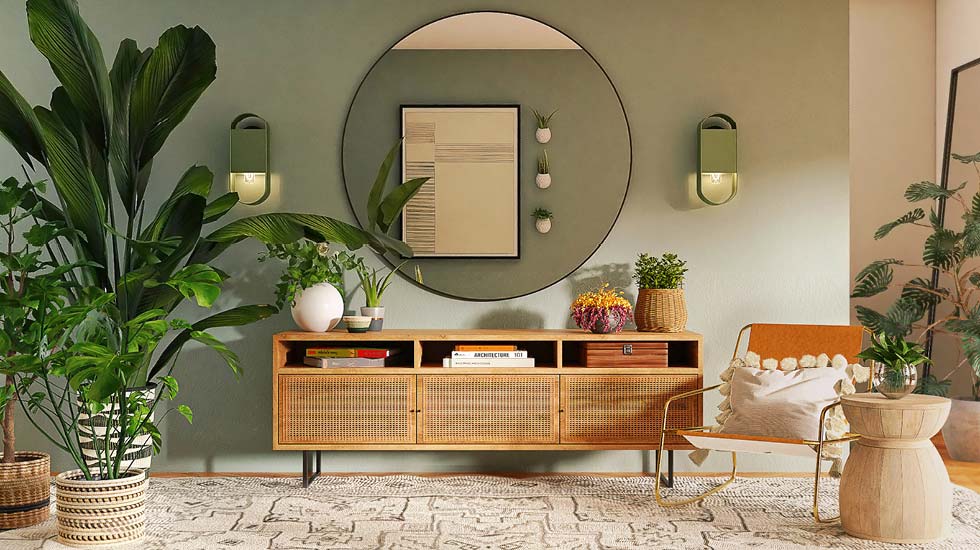

Keep reading for more on the origins of biophilic design, or you can skip ahead to find our ideas for implementing nature-inspired interiors at home.
What Is Biophilic Design?
Biophilia is a term that represents humanity’s relationship with the outdoors, exploring how we rely on interaction with nature for our wellbeing. The term literally means “the need to experience and love nature”. The principles of biophilic design in architecture and interiors are all about creating connections with the natural environment.
Stephen R. Kellert, a professor of ecology at Yale University, classified biophilic design into three parts:
- The direct experience of nature - This means actual contact with nature while indoors, and can refer to features like natural light, fresh air, plants, animals and water among others.
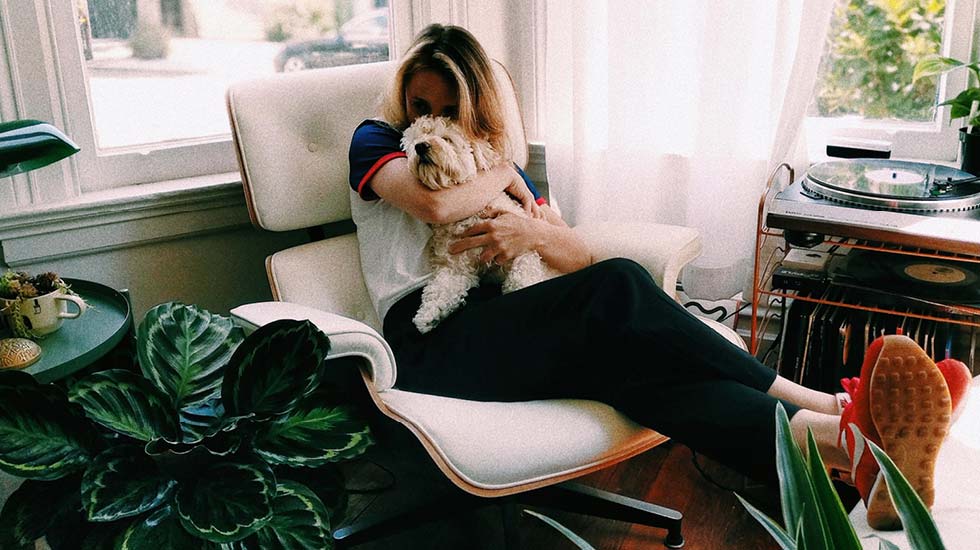

- The indirect experience of nature - The indirect experience is when we come into contact with the representation of nature. These can be pictures or imagery of the outdoors, raw material pieces like wooden beams or tables, and ornaments inspired by the natural world.
- Experience of space and place - This experience concerns mindfulness over matter, and describes using spatial features to help us with our wellbeing. Examples of this can be as abstract as creating an area for people to move freely through (similarly to the principles of Feng Shui), or creating a transitional space between indoors and outside.
Terrapin - an ecological architecture firm - expanded Kellert’s theories by creating 14 patterns of biophilic design: contributors to the patterns include scientific researchers, theorists and interior designers.


There are many benefits to creating a space using biophilic design. Some are backed by academic research, while some are more philosophical and focused on a sense of wellness. For example, research has shown the benefit of direct exposure to natural light in the workplace in making people more productive.
A 2017 study into natural light in offices found that workers who were exposed to more sunlight during the day found that they were less drowsy, made fewer mistakes and were in generally better moods.
But it’s not all about exposure to natural light. Benholm’s study in 2022 was conducted on workers in a London office space, who were placed in four different scenarios to work from. These ranged from a cubicle space with no views and no plants, to relocations to a desk with foliage and a full-height window with a view. The initial results showed that there was an overall benefit of exposure to nature, while subjects who had the most direct experience with nature logged more positive emotions than any of their colleagues.


More direct interaction with the outdoors could even lower your stress levels and heart rate, benefiting your overall mental wellbeing. A study by Environmental Science and Technology in 2014, found that moving from built-up urban areas to greener surroundings caused a huge increase in mental wellbeing. Those who moved to towns and cities with dedicated green spaces also found their mental health improving, strengthening the argument for biophilic architectural design.
These studies are perfect for helping us understand why we should incorporate biophilic design into our interiors, so keep reading to find out how you can use the principles of this research to help you create a healthy, happy and nature-inspired home.
13 Biophilic Ideas For your Home and Garden
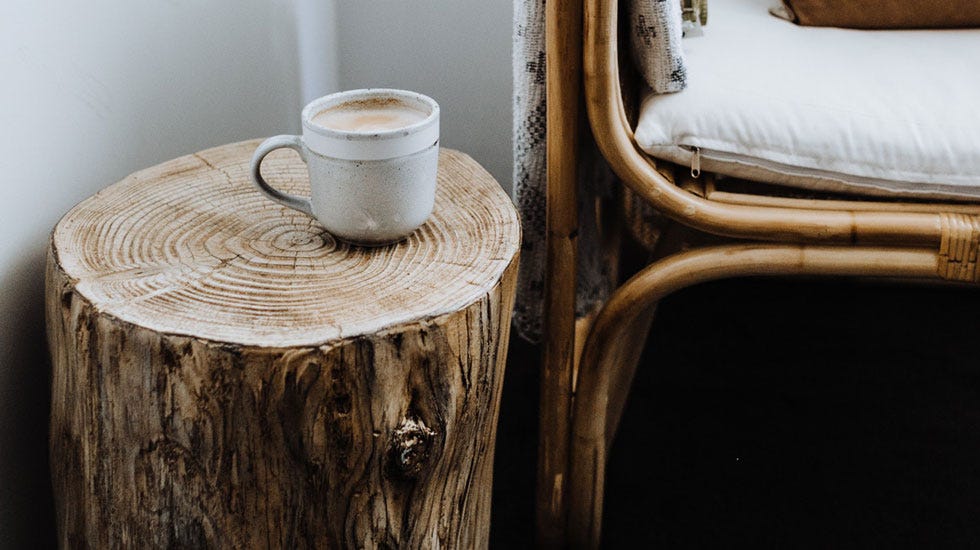

Immerse yourself in nature through biophilic design at home. Create calming spaces filled with green and raw materials, and design visual connections to the outdoor world with these 13 ideas.
More natural materials - Adding the outdoors into your home through natural materials will help you create more indirect experiences with the outside. Décor, accessories and pieces made of wood, wool, clay, cork and rattan can add a classic outdoor look to your space. If they’re recycled or reclaimed pieces, even better!
For those with a bit more budget to play with, using raw or unfinished wooden floors and furnishings are ideal for adding an outdoorsy feel. If you’re investing in a complete revamp, marble can add a touch of natural elegance thanks to its unique textures and patterns, especially when paired alongside wooden furniture and soft wool.
Create a living wall - Immerse your home in lush greenery with a living wall. Plants are natural dehumidifiers and air purifiers, so covering a quarter of your room’s walls with them will look amazing, and you’ll reap the health benefits of breathing in cleaner air.
The possibilities are endless for living walls too. You can create them by hanging pallets, a trellis or building floating shelves. When it comes to choosing plants, it’s a good investment to pick hardy greenery like succulents, especially if you’re not confident in keeping them thriving! If you’re someone who’s more practical with your flora, why not make an indoor herb garden? It’ll smell incredible and save a shopping run for your home cooking.
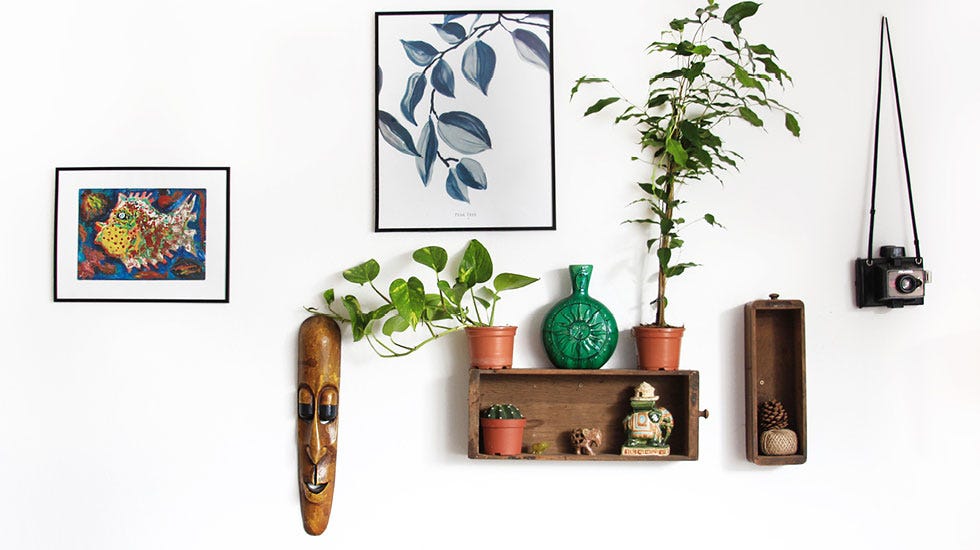

Let there be light! - Adding as much natural light as possible throughout your home is a crucial element of biophilic design. The easiest way to maximize the sunlight is to simply reposition pieces of furniture to get more vitamin D in your life directly through your windows. This is especially important in the mornings, as we tend to spend a lot of our time indoors exposed to cold, artificial lights.
If you can spend a little extra, replacing heavy curtains with blinds will allow more dappled light into your space and means your TV or work screens don’t get exposed to sunlight all day.
If you’re not blessed with direct sunlight through your windows, your lighting choices can recreate the effect of natural rays. Cold artificial light is also a no-go for biophilic interiors, as you need to mimic the glow of the sun with your lamp choices.
Spread floor lamps, sconces and side lights throughout your space to create a warm ambient light. They’ll become especially useful in the winter months as you look to imitate sunlight in your home. You can add to this by lighting candles through your space, especially those that are scented with forest or outdoor blends so you can have a fuller experience of nature!
Fresh air is good for you - This might seem obvious, but you can improve your enjoyment of your home immediately by opening your windows more often, so you can feel the benefits of outdoor air. More fresh air flowing through your space is great for increasing your oxygen levels, and also lets naturally occurring airborne toxins from cooking and cleaning leave your home safely.
Biophilic design isn’t just visual, it’s an opportunity to let all your senses experience the benefits of nature. So don’t forget sounds, alongside the fresh feeling. There’s nothing quite like listening to the rain against your window when you’re sitting safely indoors, especially as you can watch your outdoor plants get fed on your balcony or patio.
The comfort of water - A water feature will help you build a deep connection to your surroundings through direct and indirect experiences! Anything from a fountain to a fish tank will help you relax through the sound of flowing water.
If you don’t have the funds or space to create a water feature indoors or in your garden, you can still play with this principle. Recreate being close to Mother Nature’s white noise by listening to running water noises through in-home speakers, and fill your space with imagery of bodies of water.
Organic shapes are key - Capture the essence of a natural landscape with the décor you choose. Soft curves, abstract and rough forms and asymmetric accessories will help you simulate the beautiful imperfections of nature. A simple way to mimic this effect would be to mix and match your furniture so your space is filled with purposeful asymmetry. You can also evoke nature through patterns on your furnishings and décor that imitate the repetition you can find in nature - think fern leaves, rings inside tree trunks and waves within waves when you look out to sea.
Modernist and mid-century styles are also ideal trends to follow if you’re looking for inspiration for this aesthetic. They tend to follow earthy styles and colorways, ensuring you maintain a naturalistic palette.
Natural colors - You can follow two routes when it comes to deciding on your colors for biophilic interiors.
Choose a neutral color palette that follows a more subdued path if you’re looking for more saturated tones. Oranges, browns and blues give you a more organic look and create a soothing contrast against any greenery you choose to place through your home.
If you’re looking for a more vibrant way to inject color and pattern, wallpaper is your friend! Choose plant prints everywhere and go bold with décor and accessories. Lemon yellow, berry pink and luxurious off-white will complement your green interiors while maintaining an indirect connection to nature.
Invest in patina-friendly furnishings - If you’re looking to buy material pieces that are made of copper, brass, leather or marble, try to make sure they will patina over time. Patina is a chemical process that occurs naturally on these materials over time, where a thin layer forms over them and creates new colors and textures.
The best way to ensure this is to buy the highest-quality leather and marble so they look better with age. With metals, the more exposure they get to air and water, the quicker they change their color thanks to the patina effect. The longer you have them, brass pieces will start turning a greenish shade, while copper looks a little bluer.
Use patina pieces to benefit your biophilic interiors. As they age, they can simulate the changing of natural landscapes and add new textures to your space without you needing to buy new accessories or furniture.
Mix and match height and scale - There’s no such thing as perfectly straight lines in nature, so design a space that captures the creativity of the outdoors. You can do this by adding variation to your plants. Place them at different heights - greenery can look wonderfully dramatic, especially if you’ve got a mezzanine in your home.
Curated clusters of plant pots are also the perfect way to emulate the randomness of nature, and how greenery can grow anywhere outdoors. To create this effect, place three or four plants of various heights together in corners of your room.
You can also plant pots onto each step of your stairs. This look can be styled dramatically with vines or hanging plants that spill over the edge of your bannisters. Or, mix and match by placing medium-sized plants and candles in lanterns on every other step.
Inspiration through art - Murals, prints or images that represent the outdoors provide your home with an indirect natural experience. The smaller or more isolated the images are, the less impact they have, as the aim is to evoke the emotions of being outside.
Add pictures of a mountain you’ve climbed, forest you’ve explored, or a trail you’ve walked. The idea is to reconnect you with the memories of being in that environment every time you look at the photo or art.
Encourage more wildlife - Try to grow as many native plants as possible in your garden or balcony (if you have one). This will support a more diverse ecosystem as bugs, birds and other creatures begin to come into your space, and you can watch as they begin to thrive.
If rewilding isn’t within your budget, the presence of wildlife can be encouraged by adding bird feeders or bug hotels to your garden. You can then sit back and watch from a distance as they interact with your biophilic exteriors and each other.
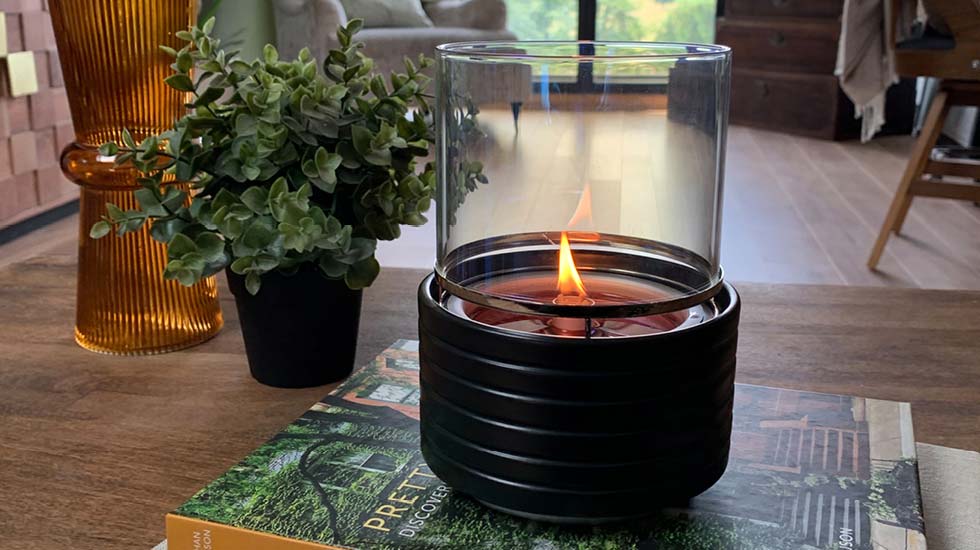

Fire it up - Surprisingly, fire plays a huge part in biophilic design! The heat, color, movement and sound of a crackling indoor flame creates a comforting ambience, and acts as a beautiful contrast to any greenery you may have added to your space.
More views for your home - Creating a room with a connection to the outdoors is crucial if you have the access. It could be as simple as placing a chair as close to the best lookout spot in your home, which means you can indirectly experience nature from a comfortable, warm place.
If you’re looking to completely renovate your space, look to add a skylight, fully-glazed exterior doors or french windows. This means you can experience nature from that room whenever you’re in there, creating spectacular views during daytime or night.
If you’re looking to immerse yourself in more nature, discover our Forest Bathing candle collection. Find more home inspiration here, and click here to see our latest fragrance and décor.




